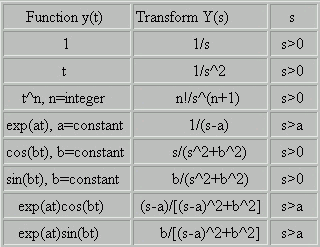The Laplace Transform of a function y(t) is defined by
![]()
if the integral exists. The notation L[y(t)](s) means take the Laplace
transform
of y(t). The functions y(t) and Y(s) are
partner functions. Note that Y(s) is indeed only a function of s since the
definite integral is with respect to t.
Examples
Let y(t)=exp(t). We have
![]()
The integral converges if s>1. The functions exp(t) and
1/(s-1) are partner
functions.
Let y(t)=cos(3t). We have
![]()
The integral converges for s>0. The integral can be
computed by doing
integration by parts
twice or by looking in an integration
table.
Existence of the Laplace Transform
If y(t) is piecewise continuous for t>=0 and of exponential
order, then
the Laplace Transform exists for some
values of s. A function y(t) is of
exponential order c
if there is exist constants M and T such that
![]()
All polynomials, simple exponentials (exp(at), where
a is a constant), sine
and cosine functions, and products
of these functions are of exponential order.
An
example of a function not of exponential order is
exp(t^2). This function
grows too rapidly. The integral
![]()
does not converge for any value of s.
Table of Laplace Transforms
The following table lists the Laplace Transforms for a selection of functions

Rules for Computing Laplace Transforms of Functions
There are several formulas and properties of the Laplace
transform which can
greatly simplify calculation of the
Laplace transform of functions. We
summarize them
below. The properties can verified using the integral
formula for the Laplace Transform and can be found in
any textbook.
Like differentiation and integration the Laplace
transformation is a linear
operation. What does
this mean? In words, it means that the Laplace
transform of a constant times a function is the
constant times the
Laplace transform of the function.
In addition the Laplace transform
of a sum of
functions is the sum of the Laplace transforms.
Let us restate the above in mathspeak. Let Y_1(s) and
Y_2(s) denote
the Laplace transforms of y_1(t) and y_2(t),
respectively, and let c_1
be a constant. Recall that
L[f(t)](s) denotes the Laplace transform of
f(t).
We have
![]()
![]()
As a corollary, we have the third formula:
![]()
Here are several examples:
![]()
Here we have used the results in the table for the
Laplace transform
of the exponential. Here are a
couple of more examples:
![]()
![]()
The translation formula states that Y(s) is the Laplace transform of y(t), then
![]()
where a is a constant. Here is an example. The Laplace transform of
the
y(t)=t is Y(s)=1/s^2. Hence
![]()
Laplace Transform of the Derivative
Suppose that the Laplace transform of y(t) is Y(s). Then
the Laplace
Transform of y'(t) is
![]()
For the second derivative we have
![]()
For the n'th derivative we have
![]()
Derivatives of the Laplace Transform
Let Y(s) be the Laplace Transform of y(t). Then
![]()
Here is an example. Suppose we wish to compute
the Laplace
transform of tsin(t). The Laplace
transform of sin(t) is 1/(s^2+1).
Hence, we have
![]()
[ODE Home] [1st-Order Home] [2nd-Order Home] [Laplace Transform Home] [Notation] [References]
Copyright © 1996 Department of Mathematics, Oregon State University
If you have questions or comments, don't hestitate to contact us.